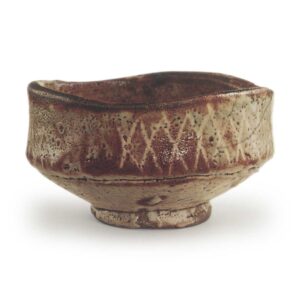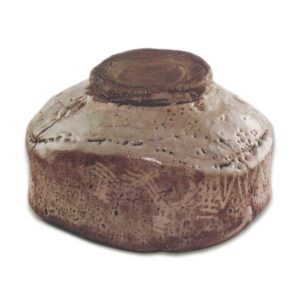

HATAKEYAMA MEMORIAL MUSEUM
Height: 7.2-8.0cm
Diameter: 13.5-14.0cm
Outside diameter of foot ring: 6.5-7.0cm
Height: 1.2cm
It is made using the Nezumi Shino technique, but the red color of the fire covers the entire side and interior of the bowl, giving it a rare finish known as Akashi-no. On the inside of the box lid, the words “Hyakue-de Munenori” can be seen, and if this is the signature, it is probably because it was used for the Hyakue tea ceremony of Rikyu, or perhaps because it was used frequently.
The clay is fired to a slightly hard consistency, and the underside of the foot ring has a slightly brownish, rusty clay taste. The foot ring is a magnificent attached foot ring, but the brushwork is rough and vivid, and it looks as if it has been carved out. The cut-out at the foot ring is particularly sharp. The narrow lines running along the edge of the tatami mat are made with the tip of the spatula, and are similar to the double foot ring. The spatula work on the rim is also superb, with the lines running freely over the slightly thick rim, showing a wonderful sense of inflection. The lines of the ridges also run around the waist like a mountain path, but the thick grooves are covered in a thick layer of glaze, and in that area, long or short cracks resembling ground fissures can be seen dotted all over. The way in which the shape of the tea bowl is strongly emphasized by skillfully using the spatula at three key points – the rim, the waist, and the foot – is a technique often seen in Shino tea bowls and is a clever technique. The inside of the bowl is also deep and spacious, and there is a single sharp lathe mark swirling around the tea pool at the bottom in a swastika shape.
The glaze is applied in the following way: a thin coat of glaze is first applied to the base, and then the pattern is carved into the glaze, after which a generous amount of feldspar glaze is applied. The glaze is applied thickly from the base to the waist, especially in the areas where the feldspar content is high, and the rich milky white glaze is beautiful. In places, the finger marks of the potter from when he was applying the glaze are visible, showing the red of the clay. In contrast to the milky white of the waist, the sides and the entire interior of the piece, which has a pattern, have a noticeably thin glaze layer, and so naturally, the fire color of the glaze changes beautifully in irregular shades of red or dark brown in those areas. The thin areas of the glaze layer look as if the glaze surface has been wiped away, but according to the findings of Yuzo Arakawa, this is because the glaze was not sufficiently thick, and so when the glaze was applied, the parts with a light composition happened to be the sides and the foot of the tea bowl, and a thick glaze was applied to these areas. This was a phenomenon that the potter had not anticipated at all. In any case, this type of red Shino is a rare example of a tea bowl, and is also the reason why this type of red Shino is so highly prized.
The pattern consists of a band of line-carved patterns that encircle the outer surface. A simple cross-shaped band pattern is decorated with triangular serrated patterns, and there are also mountains and pine trees that look like children’s drawings. The white glaze that accumulates in the grooves after carving looks like inlay, and is the same technique as that used for the usual Nezumi Shino ware. In particular, the mountains and pine trees have been scratched with simple combing, and the soft, carefree lines of the drawing are very attractive.
The history of this piece is unknown before it was in the collection of Hatakeyama Kazukiyo. It is currently in the collection of the Hatakeyama Memorial Museum. This is a hidden masterpiece that has rarely been introduced to the public.
There are no other notable accessories, other than the box with the inscription by Souchi. There were several tea masters who used the name Souchi, but the most famous were Ken Souchi from around the Kyoho era and Konoike Souchi from around the Meiwa era. There were also Nakamura Souchi from around the Meiji era and a few others.



